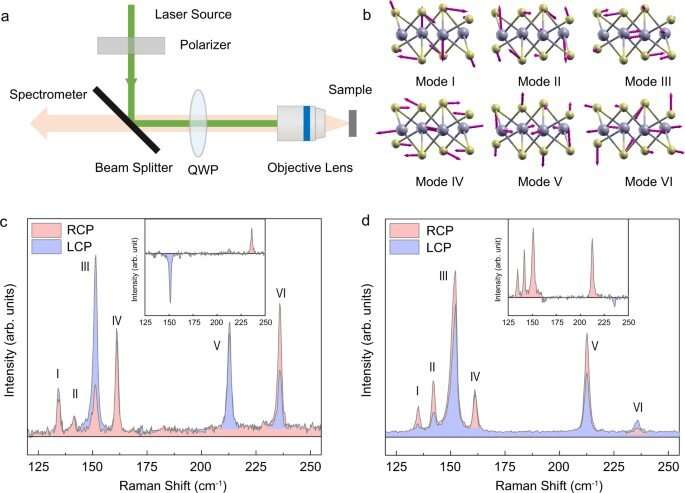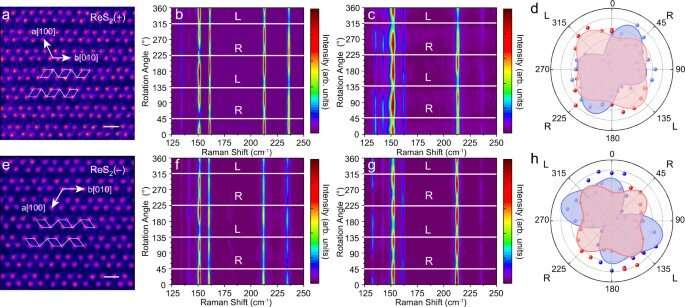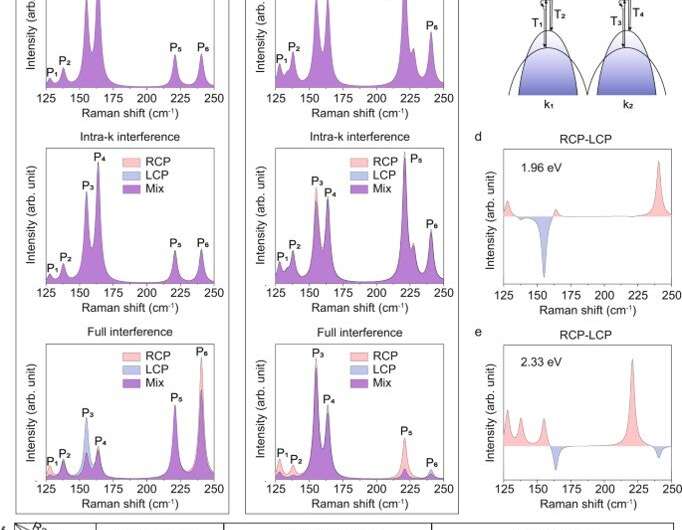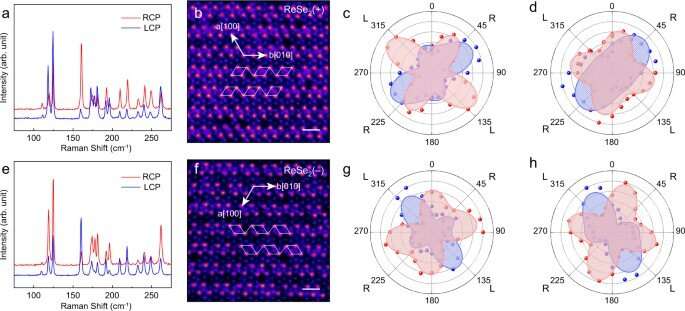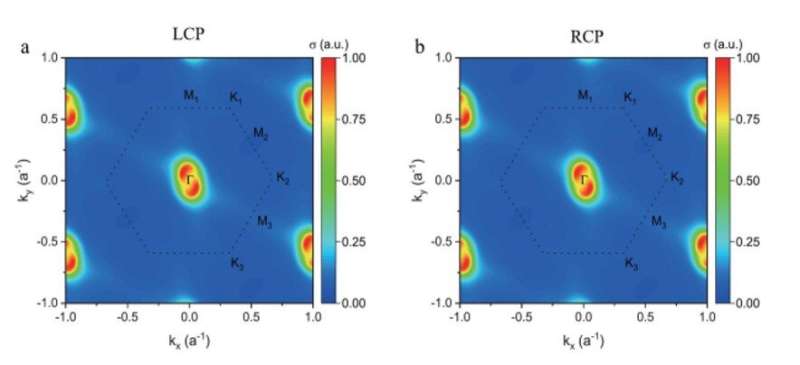Chiral Raman response of monolayer ReS2. (a) Optical setup of the chiral Raman scattering measurements; (b) The eigenvectors of the Raman-active vibrational modes (I–VI) according to density functional theory (DFT) calculations; (c, d) Circularly polarized Raman spectra for the Re vibrational modes of 1L ReS2 (EL = 1.96 eV c and 2.33 eV d). The insets depict the difference between the Raman intensities of 1L ReS2 excited by RCP and LCP. Credit: Nature Communications (2022). DOI: 10.1038/s41467-022-28877-6
Raman scattering spectroscopy is a necessary and accurate method to characterize lattice structure and probe electron-photon and electron-phonon interactions. In the quantum realm, electrons at the ground states can be excited to intermediate energy levels by photons, then be coupled to phonons to emit photons with changed energies. The elementary Raman processes can interfere with each other via possible pathways to give rise to intriguing scattering effects. In a new report now published in Nature Communications, Shishu Zhang and a research team in nanochemistry and materials science in China described quantum interference that can lead to significant chiral Raman response in monolayer transition metal dichalcogenides with triclinic symmetry and showed a large circular intensity difference for monolayer rhenium dichalcogenide. The results revealed chiral Raman spectra as a new manifestation of quantum interference to Raman scattering processes to inspire the induction of chiral optical responses in materials.
Quantum interference
Phonons can be coupled to photo-excited electrons during a Raman scattering process to relax to the ground state by emitting scattered photons. The energy difference between the incident and scattered photons can provide the frequency of a Raman mode and reveal the structural information of materials. Scientists can also more effectively estimate the intensity via electron-photon and electron-phonon interactions. Quantum interference can occur between different elementary pathways of scattering to result in the regulation of inelastic scattering efficiencies. Materials scientists have only reported the quantum interference effect in Raman scattering for two dimensional (2D) layered materials including electrostatically doped graphene and few layer molybdenum ditelluride. While quantum interference is challenging to observe, it is essential to understand fundamental interactions between light-matter to potentially regulate light scattering in materials. In this work, Zhang et al. used Rhenium dichalcogenide (ReX2, where X equals sulfur or selenium) as a layered transitional metal dichalcogenide material with triclinic symmetry. Researchers have shown how the Re atoms in ReX2 (X = sulfur or selenium) crystals moved away from metal sites to form Re4 parallelograms to form a distorted crystal structure and give rise to anisotropic in-plane properties including carrier mobility, photoluminescence and Raman scattering.
Circularly polarized Raman spectra of ReS2 with different vertical orientations. (a, e) STEM image of ReS2 (+) and ReS2 (−), scale bar: 0.5 nm. (b, c, f, g) Raman intensities for different rotation angles excited by 1.96 eV b, f and 2.33 eV (c, g) lasers. The polarization states for excitation are indicated by white lines, where L and R refer to left-handedness and right-handedness. d, h Polar plots of normalized Raman intensity of 132 cm−1 mode excited by 1.96 eV (red) and 2.33 eV (blue) for ReS2 (+) d and ReS2 (−) h. Credit: Nature Communications (2022). DOI: 10.1038/s41467-022-28877-6
The experiments
Scientists are still exploring the interactions between photons, electrons and phonons during the process of chiral Raman scattering. Zhang et al. reported the chiral Raman scattering observed in monolayer ReS2 and ReSe2 excited by circularly polarized light. The team induced large circular intensity via quantum interference between first-order Raman processes at different K-points in the Brillouin zone. The calculated chiral Raman spectra based on the quantum interference effect agreed well with the experiments. In the optical setup for chiral Raman scattering measurements, they used a quarter wave plate to produce right-handed or left-handed circular polarization for excitation. The scattered light could pass through the same quarter wave plate for collection without an analyzer. During the experiments, Zhang et al. mechanically exfoliated a single-layer ReS2 on a fused silica substrate and obtained optical and atomic force microscopy images. They noted the thickness of the ReS2 monolayer and calculated the eigenvectors of the Raman-active vibrational modes via density functional theory. Due to its triclinic symmetry, the layered ReX2 had two vertical orientations. Similarly, chiral Raman scattering spectra of the monolayer contained two different orientations, which Zhang et al. distinguished using annular dark-field scanning transmission electron microscopy. To further understand chiral Raman scattering, the team explored scattering efficiencies of ReS2 (+) and ReS2 (-), as a function of rotation angle of the quarter wave plate. Chirality in two-dimensions arose when distinct enantiomers are confined to a plane; however, the method in which chiral Raman responses arise from the microcosmic view of the electron/photon and electron/phonon interactions is still not understood in this instance.
Calculated results of chiral Raman scattering in 1L ReS2. Raman spectra from three different interference pathways (no interference, intra-k interference, and full interference) excited by both RCP and LCP for (a) 1.96 eV (b) 2.33 eV photon energies. (c) Schematics of different quantum pathways in Raman process. (d, e) Calculated CID spectra for 1.96 eV and 2.33 eV photon energies. (f) The calculated CID values of the six Raman modes for the three interference patterns. Credit: Nature Communications (2022). DOI: 10.1038/s41467-022-28877-6
Theoretical calculations and chiral Raman response
To calculate the large circular intensity differential observed in ReS2, the team measured the first-order Raman scattering via third-order perturbation theory. The scientists calculated the Raman intensity and Raman tensor via the electronic band structure and phonon dispersion of ReS2. The results of the calculated Raman spectra showed how chiral Raman scattering of ReS2 arose from the interference effects between all possible quantum pathways of elementary transitions. The scientists noted that while quantum interference effect in Raman scattering was reported in other 2D materials, this was a first-in-study outcome, leading to a pronounced chiral Raman response. The team showed how chiral Raman scattering was also observed in other triclinic 2D layered materials, such as ReSe2, where the crystal structure of ReSe2 had similarities to ReS2.
-
Circularly polarized Raman spectra of ReSe2 with different vertical orientations. (a) Circularly polarized Raman spectra of ReSe2 (+) orientation (EL = 2.33 eV); (b) STEM-ADF image of ReSe2 (+), scale bar: 0.5 nm.; (c, d) Polar plots of normalized Raman intensities of modes at 119 cm−1 c and 162 cm−1 d for 1.96 (red) and 2.33 eV (blue) excitation energies; (e) Circularly polarized Raman spectra of ReSe2 (−) (EL = 2.33 eV); (f) STEM-ADF image of ReSe2 (−); (g, h) Polar plots of normalized Raman intensities of modes at 119 cm-1 g and 162 cm-1 h for 1.96 (red) and 2.33 eV (blue) excitation energies. Credit: Nature Communications (2022). DOI: 10.1038/s41467-022-28877-6
-
Quantum interference in ReS2. Optical absorption of (a) left circularly polarized and (b) right circularly polarized laser of 1.96 eV. Credit: Nature Communications (2022). DOI: 10.1038/s41467-022-28877-6
Outlook
In this way, Shishu Zhang and colleagues described how quantum interference in Raman scattering can provide a strong chiral response in 2D enantiomers of single-layer triclinic ReX2 where X equaled sulfur or selenium. The team noted how Raman scattering efficiencies of left-handed circular polarization and right-handed circular polarization excitations could be clearly distinguished and found to depend on Raman modes and their excitation photon energies. The findings revealed how quantum interference can lead to a pronounced chiral response of Raman scattering in materials. The team showed that quantum interference can be a generic effect in inelastic optical scattering, evident as a constructive or destructive interference, dominant more so when the excitation photon energy is larger than the bandgap of materials. The results are applicable to bulk triclinic crystals such as ReS2 and ReSe2.
More information: Shishu Zhang et al, Quantum interference directed chiral raman scattering in two-dimensional enantiomers, Nature Communications (2022). DOI: 10.1038/s41467-022-28877-6
C. V. Raman, A Change of Wave-length in Light Scattering, Nature (2008). DOI: 10.1038/121619b0
Journal information: Nature Communications , Nature
© 2022 Science X Network
